October 2016 – Zion National Park in Utah is filled with towering rock formations that rise up alongside the Virgin River. It’s located in the heart of National Parks country, just 70 miles from Bryce Canyon National Park, 70 miles from Cedar Breaks National Monument and 110 miles from the North Rim of the Grand Canyon.

Zion National Park is a fantastic destination for an RV trip
The views in Zion Canyon are utterly breathtaking.

Zion Canyon view – spectacular!
We had visited Zion National Park before, both in a tent and also with our first full-time RV. But each of those visits had been more of a survey trip than an in depth immersion. This time we took our time exploring.

The Watchman at sunset
There are many ways to enjoy Zion National Park. One of the most fun ways to get an introduction is to walk along the Pa’rus Trail that goes alongside the Virgin River right from the Visitors Center.

We walked the Pa’rus Trail and crossed several bridges over the Virgin River
This is a popular trail both for walking (including dog walking) and for riding bikes as well.

Biking is a great way to get an overview of Zion National Park, especially on the Pa’rus Trail
We took our bikes on it one day and saw some fabulous views.

Cycling the Pa’rus Trail

Pa’rus Trail – What a ride!
Rock pinnacles thrust up from the earth on all sides, and the trees were changing colors here and there in the cool October air.

The Watchman in fall color.
We saw some little critters. A bird flitted between the branches of a tree and a ground squirrel paused to have a look at us.

.

.
The main road through the park is the 9 mile long Zion Canyon Scenic Drive which dead ends in the heart of the main canyon. Cars are restricted on much of this road and are forbidden for the last half of it from Spring to Fall, making it absolutely fabulous for a bike ride.
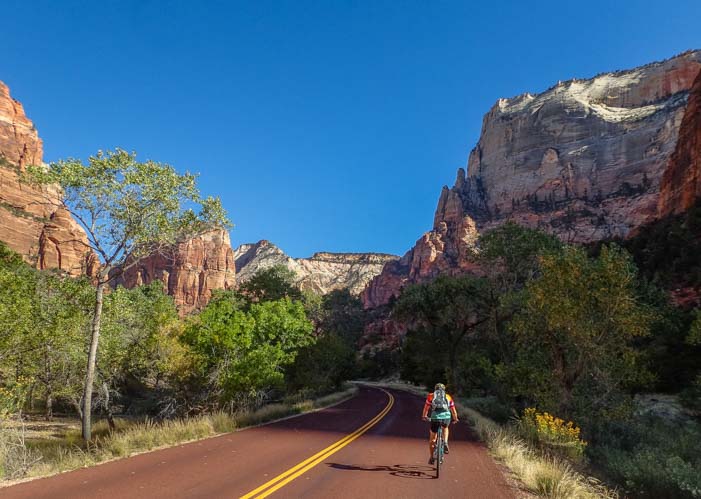
Cycling Zion Canyon Scenic Drive into the heart of Zion’s main canyon: Zion Canyon
Cyclists share this road with both chartered tour buses and the Park’s free shuttle buses, but the buses are infrequent enough that for most of the ride we had the entire road to ourselves. Awesome!
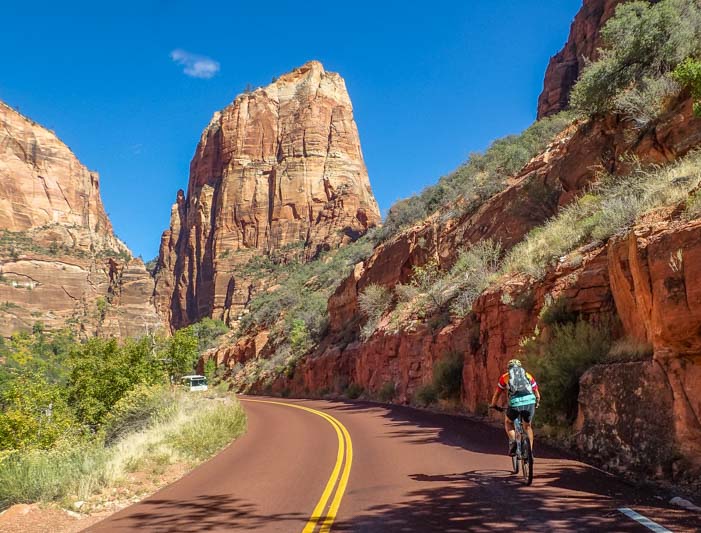
We LOVED riding our bikes on Zion Canyon Scenic Drive
The erosive power of the Virgin River is responsible for Zion Canyon, and the stunning scenic drive runs alongside it.
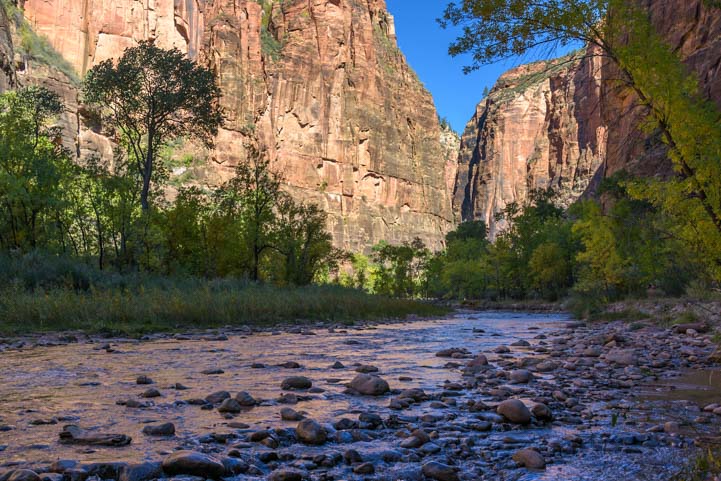
The Virgin River cuts between the rock walls.
The Virgin River is shallow and filled with small rocks in some places.

.
As we got deeper and deeper into Zion Canyon, the towering rock walls closed in all around us.
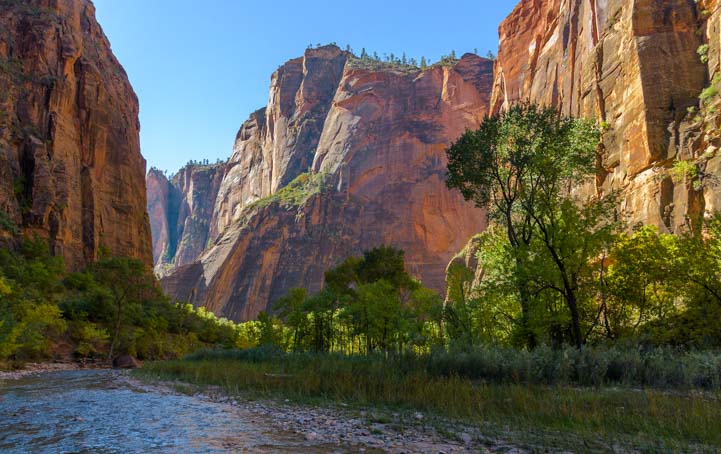
Tall cliffs and magical light in Zion Canyon
The canyon walls grew steeper and steeper, rising up around us on all sides as we approached the end of the road.
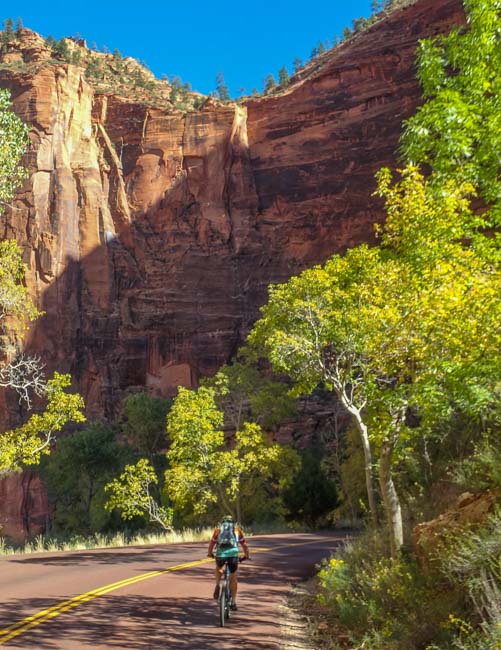
Views everywhere
Early in the morning, much of Zion Canyon was in shade because the rock walls are so high.

Light and shadow change all day long on Zion’s cliffs.
But later in the day the sun rose high enough to light it up. As the sun traversed the sky, the walls on one side of the canyon were lit first. Then they became shaded and the walls on the other side lit up.
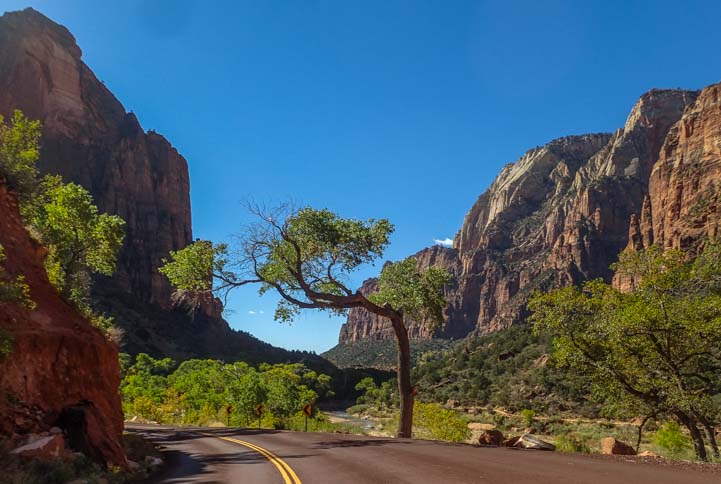
A gorgeous view from Zion Canyon Scenic Drive.
Amazingly, Zion Canyon National Park has a brewpub right outside the park. After a day of sightseeing, no one had to twist our arms to join the other happy tourists and find a table with a view to quaff a pint!
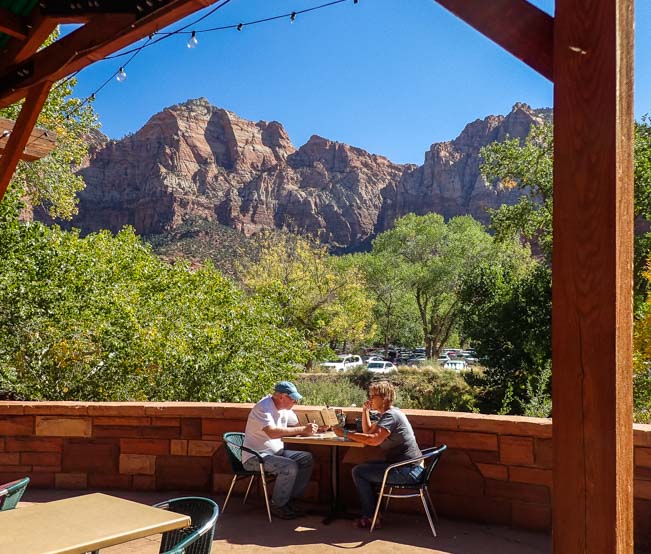
What a great way to unwind after a day of sightseeing.

A brew with a view!
In the late afternoon we watched the full moon rise through the sunset.
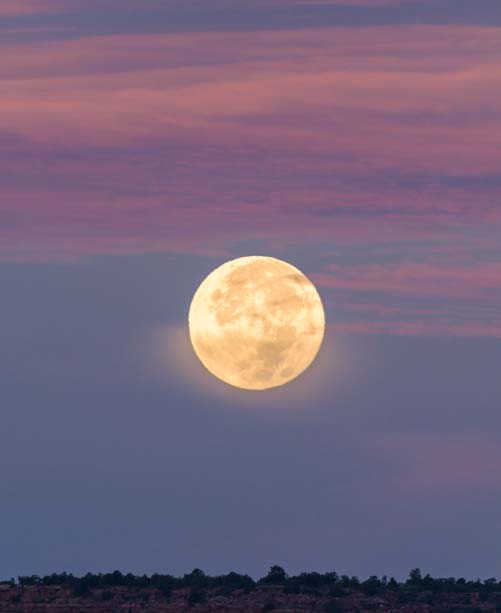
.
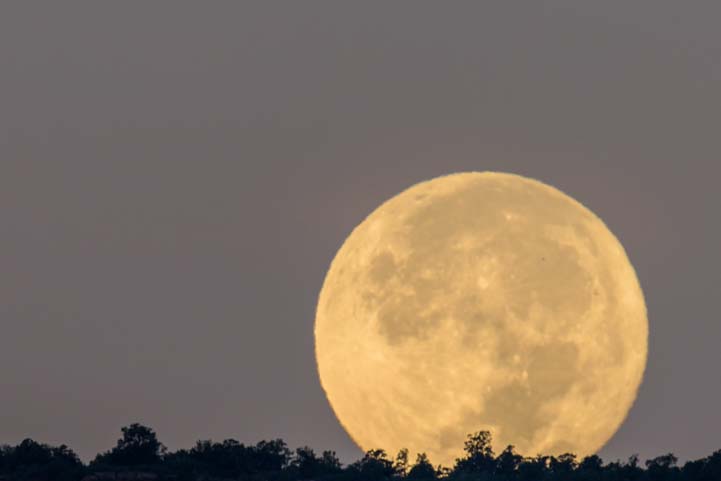
.
Zion Canyon is essentially an enormous (and enormously beautiful) box canyon, i.e., a dead end. And Zion National Park is immensely popular. A ranger told me 4 million people had already visited the Park in 2016 when we got there in October.
So, getting all these people in and out of the box canyon is no small trick. Zion National Park has done an amazing job of handling the traffic and the crowds.
For starters, car traffic is highly restricted for all but the Winter season. The parking lot at the Visitor Center fills as early as 8:00 a.m. during the peak season between Spring and Fall.

Forget about parking at the Visitors Center after 8:00 a.m.
Luckily, there is parking in the town of Springdale, especially at the south end of town.
There are two excellent free shuttle systems to ferry people around both the town of Springdale and Zion National Park.
The Springdale Shuttle takes visitors through town and runs all the way to the Zion National Park entrance and visitors center.
The Zion Canyon Shuttle takes visitors from there all the way through the National Park to the end of the box canyon (which is also the start of the very popular Narrows hike).

Free Shuttle BusesThe Zion Canyon shuttle (at bus stop #3 above) is efficient and easy to use.
A different shuttle — the Springdale Shuttle — serves the town of Springdale where you can park.
So… Park in town, take the Springdale Line to the Canyon Line which goes into the Park
There are about 9 stops on each route, and each one takes about 40-45 minutes end to end.
Passengers on the Zion Canyon Shuttle get to hear an interesting recording that tells all about the park, both its natural history and its human history. We took both shuttles quite a few times during our stay, visiting various overlooks and doing various hikes, and we found it easy and convenient.
Cars can drive into the park as far as the turn-off onto Route 9 East that goes through the Zion-Mt. Carmel Tunnel. People staying at Zion Canyon Lodge, which is beyond that point, can get a pass to drive as far as the lodge and park their cars there. However, during the peak season when the shuttle runs (Spring to Fall), all cars are forbidden beyond the Lodge. During the Winter, the shuttle runs only on holidays, and at that time cars are allowed to drive the full length of Zion Canyon Scenic Drive.
Anyone entering the canyon with a big dually truck like ours, or towing a trailer or driving a motorhome, will be informed that their vehicle will require a pilot to go through the Zion-Mount Carmel Tunnel on Route 9. There is a fee for this, as traffic in both directions has to be stopped. Years ago, we went through the Zion-Mt Carmel tunnel and drove the wild switchbacks of Route 9 in a minivan, and the drive is out of this world. So, if you have a car, do it!!

South Campground is right next to the Pa’rus Trail
There are two campgrounds that can accommodate small to mid-size RVs. Both are close to the Park entrance. South Campground is, ironically, the more northerly of the two. Watchman Campground is the more southerly one!
During our stay in October, the leaves were just beginning to change into their autumn colors. The peak for fall color is generally around the first week of November.

Fall colors peak at Zion in the first week of November (this photo is late October)

.
Zion National Park is a world class destination and we absolutely loved our stay this year! We’ll have more blog posts from our time there. In the meantime, we’ve got lots of links below to help you plan your visit.
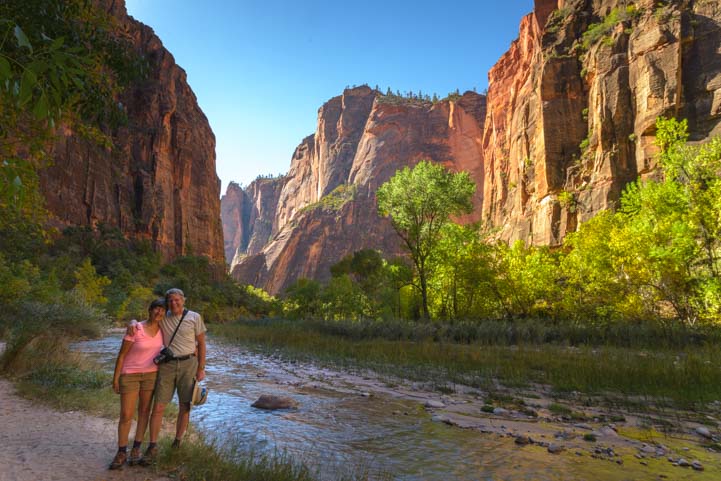
Zion National Park is an incredible destination
Subscribe
Never miss a post — it’s free!
More info about Zion National Park:
- Zion National Park Official Website – National Park Service
- Zion National Park Official Maps – Scroll down to see them all
- Zion National Park Shuttle System – An overview
- Springdale Shuttle System – An overview
- Parking Map for the Springdale Shuttle – Parking is easiest to the south
- Zion-Mt Carmel Tunnel – Bigger trucks pay a fee for a pilot
- Zion National Park Campgrounds Inside the Park – Two in Zion Canyon and one in Kolob Canyon
- More RV Park Options – RV Park Reviews
- Zion Canyon Brewing Company – A great lunch stop!
- Locations: Campgrounds, Pa’rus, Lodge, Watchman, Narrows & Zion-Mt Carmel – Interactive Google Maps
Blog posts from our RV trips to Zion National Park:
- Zion National Park’s Hidden Jewels – Off the Beaten Path in an RV! 12/06/17
- Zion National Park “West” RV Trip – Gorgeous Kolob Canyons! 12/22/16
- Zion NP, Kodachrome Basin & Snow Canyon, UT – Great Red Rocks! 10/31/07
Blog posts from the area near Zion National Park:
- Best Friends Animal Sanctuary & Southwest Wildlife Foundation in Utah 09/15/08
- Coral Pink Sand Dunes State Park – Shape Shifting in the Sand! 11/08/17
- Johnson Canyon Movie Set – A Spooky Ghost Town – Happy Halloween! 10/27/17
- Kanab – Hub for the National Parks + Gorgeous Canyons Nearby! 11/12/17
- Kanab & Alton, UT – Whoa!!! 09/29/08
- Sand Hollow State Park, Utah – An Oasis in the Desert! 11/21/17
- Zion National Park “West” RV Trip – Gorgeous Kolob Canyons! 12/22/16
Blog posts from all our travels to National Parks and UNESCO World Heritage Sites in North America
Our most recent posts:
- Lake Powell – Heart of Glen Canyon National Recreation Area 05/10/24
- Quick Release Pull Pins for Fifth Wheel Landing Jacks – YES! 05/03/24
- Sheep May Safely Graze (in the Mountains with Dogs!) 04/26/24
- How to Replace Electric Fifth Wheel Landing Legs – Easy DIY! 04/19/24
- Lost Dutchman State Park: GORGEOUS scenery & RV campground! 04/12/24
More of our Latest Posts are in the MENU.
New to this site? Visit RVers Start Here to find where we keep all the good stuff!!
<-Previous || Next->

Hi Emily! We are outside of Zion right now. Staying in Leeds for the month. I have a couple questions. First, one of your last photos of your rig in front of the mesa with the beautiful sky…is that a boondocking spot? Can you say where? Also, there has been some talk among fellow bloggers about the amount of time writing and posting takes such that some are backing off from blogging altogether. I have noticed that your travel posts are considerably after the fact. Does writing belatedly help at all with the time it takes, or does this have more to do with magazine article leadtimes than anything else?
Hi Ed – We always boondock but we don’t share our boondocking locations for the reasons given here. As for blogging, it is an incredibly time consuming process, which is why we are so grateful to our readers who say thanks by using one of our many links to Amazon (in the ads below or in the menu bar) before putting items in their wish list or shopping cart. A small commission comes our way at no cost to them, and it is a wonderful pat on the back. We do this for our fellow bloggers too!
A typical travel post like this one takes me 8-10 hours to produce (this one actually took about 12 hours). Technical posts like our many posts on solar power, doing a trailer disc brake conversion, and our various articles about full-time RVing each took me about 70+ hours to create. Several of the most technical articles actually took me over 100 hours to produce.
This is because there is not just writing and photo selection and editing, but there is research for reference links, fact checking, overall layout work and all the technical things related to creating a website that has menus (for both desktops and mobile devices) and internal and external links.
Plus, this blog is built on WordPress, a continually changing software platform that requires constant re-adaptation, learning and frequent changes of work flow on my part as the powers that be upgrade and enhance the main software and the many plugins I rely on. Sometimes the software engineers who create WordPress and its plugins actually break the platform, causing me extra work to pick up the pieces.
Some days I sit on hold with the web host for hours trying to figure out why my site is down or faltering. Sometimes I spend a day or two testing a new piece of software, like the mailing list software that gets this blog out to our readers, only to decide that it can’t do what I need it to do. Those hours aren’t “wasted” time exactly, because the work needs to be done to ensure I am getting the best value possible from the services I purchase, but it sure doesn’t help produce new blog posts!
So there is a ton of behind-the-scenes work in maintaining a blog that has nothing to do with writing blog posts.
Mark and I each take an average of 35,000 photos each per year. So it takes us a lot of time to go through our photos, select the best ones, and post-process them (this is modern day “dark room” work). After the photos are ready, then I can begin putting a blog post together.
So, at times when we aren’t doing anything but sight-seeing, I can dedicate my evenings to writing blog posts and keep the blog up to date to within about 2 weeks of when the events happened. Lately, however, I have had many other things going on in my life, including Christmas prep, socializing with friends and family in the evenings, and writing a bunch of magazine articles, so I have had to let the blog posts slip a bit.
I think people enjoy reading about beautiful travel destinations and learning RVing tips from this blog whenever I can get them published, so I have learned not to feel pressured about blogging and simply produce whatever I can whenever I am able to do it!
After all, it is a labor of love for me, and it is free entertainment for my readers.
Thank YOU for being such a loyal reader and appreciating what I post here.
We are relatively new retirees (just passed one year) and have enjoyed following your posts. We have spent time in AZ, TX, NM and CA and find your posts very helpful in arranging our travel. Also very much enjoy your technical posts. Keep up the good work! And Merry Christmas!
Thank you! Enjoy your travels and Merry Christmas to you as well!!
I loved those pictures of the moon and the red sky at sunset! I remember them from our time in Arizona, way back in the late 70’s! beautiful!
We love the southwest’s sunrises and sunsets and are always so excited to come back to them after being away!!
Did you camp inside the park? I think our 38-foot fifth wheel would be too large for their campgrounds.
As I mentioned in the article, the campgrounds inside the park are suitable for small to mid-size RVs. There are RV parks outside the park that can accommodate big rigs, and I provide a link to the Springdale, UT, RV Park Reviews page in the reference section at the end of the article to give you an idea of what’s nearby.